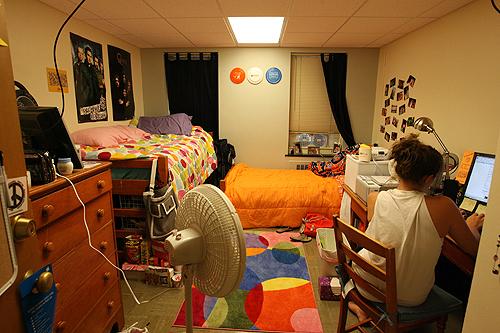Back-to-school spending increases

Lynley Tucker and Rachel Ramsey, freshmen in LAS, study inside their room on Wednesday. Erica Magda
August 30, 2007
If the power ever went out at the University campus, Andrew Werner wouldn’t even notice.
In fact, Werner and his roommates in Illini Tower would probably be too busy playing video games against each other – in separate rooms. The HD LCD TV in his bedroom happens to be connected to the 30-inch HDTV in his living room.
Werner, sophomore in Business, has an uninterruptible power supply, or UPS. It would keep his laptop, TVs and other electronics on in the event of a power outage.
Werner’s tech-savvy hookups are only one of many factors driving the increase in back-to-college spending.
According to the 2007 Consumer Intentions and Actions survey released this month by the National Retail Federation, the average sophomore will spend $748.
Get The Daily Illini in your inbox!
Werner said he spent about $950, even though he hunts for bargains.
“I like to stay on top of things,” Werner said. “I’m a management information systems major, which is pretty much (information technology) and computer stuff. A lot of it is also for personal enjoyment.”
Nationally, the survey predicts that students and parents will spend more than $47 billion on back-to-college purchases, a $10 billion increase from 2006-2007 school year. Of that $47 billion, $12.8 billion will be spent on electronics and $15 billion on textbooks.
“This is a very busy time of the year for us,” said Ana Williams, media relations spokesperson for Target Corporation.
The survey also predicts that freshmen will spend an average of $1,200 this year.
Stacey Appiah, freshman in Business, disagreed with the projected figure because she had to buy everything from residence hall furnishings to school supplies.
“I spent way more than a thousand dollars,” Appiah said. “I think I spent $450 on books alone. Then, I made some random trips to Wal-Mart.”
The survey also predicts that the amount spent on residence hall and apartment furnishings will increase due to emphasis from marketing campaigns.
“As a whole, we generally look at different venues of communication styles, and we look at popular items and trends popular to the college-age guest,” Williams said. “We try to stay fresh and innovative to speak to this age group.”
Appiah said she found that commercials and advertising could cause students to bring more than they should.
“In my dorm, we have regular furniture, and there is no room for more,” she said. “(Commercials) made it seem like you were going to have a big living space.”
In terms of making purchases for their rooms, Werner said that students should not rush into a shopping spree at the end of the summer.
“Buy as you need it because you need to know how much space you have,” he said. “And remember that you’ll be spending money on other stuff during the year, like if you want to go out or need to buy books.”






